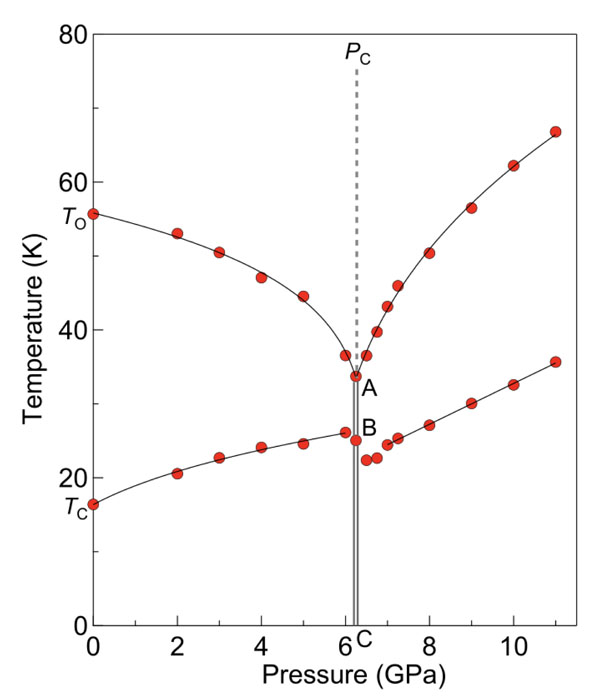Pressure-Induced Multicriticality and Electronic Instability in the Quasi-Kagome Ferromagnet URhSn
PI of Joint-use project: A. MauryaHost lab: Uwatoko Group
URhSn crystallizes in the hexagonal ZrNiAl-type structure without inversion symmetry. The U atom forms the quasi-kagome structure, in which the magnetic frustration is potentially expected. The rare-earth based family, such as CePdAl and YbAgGe, indeed shows the novel magnetic phase diagram due to this magnetic frustration. In U based system, the ferromagnetic quantum critical behavior is well established, for example in UCoAl and URhAl, where the wing-shaped temperature-pressure-field phase diagram associated with the first order metamagnetic transition is demonstrated.
In URhSn, two successive transitions had been reported in the previous literature. The one is the ferromagnetic Curie temperature at TC = 16 K with the relatively large ordered moment of 2.1 μB directed along c-axis, the other transition occurs at TO = 54 K with the large specific heat jump. The origin for the latter transition is still unclear from the neutron scattering experiments and Mossbauer spectroscopy, meaning that the order parameter remains “hidden”. Thus a quadrupole or multipole order is inferred [1].
In this study, we performed the electrical resistivity measurements under pressure up to 11 GPa [2]. The two transitions are abruptly switched to the two different transitions at the critical pressure, PC ~ 6.3 GPa, indicating two bicritical points associated with the Fermi surface reconstructions.
High quality single crystals were grown using the Czochralski method in a tetra-arc furnace. The obtained single crystals were then annealed at 800 °C under vacuum for one month. The residual resistivity ratio (RRR) is about 40, and the de Haas-van Alphen oscillations are successfully detected, revealing the mean free path of ~1000 Å, indicating the high quality of our sample. A bar shaped single crystal was set into a cubic anvil cell for the resistivity measurements at high pressure up to 11 GPa and at low temperatures down to 2.5 K. The electrical current was applied along the [11-20] direction.
Figure 1 shows the temperature-pressure phase diagram determined from the resistivity measurements. Two transitions at TC and TO were clearly detected with two kinks in the resistivity measurements. Interestingly, TO decreases with pressure, while TC slightly increases up to the critical pressure, PC ~ 6.3 GPa. Further increasing pressure, TO increases, displaying a sharp minimum at Pc as a function of pressure, while TC drops suddenly, and increases again. These abrupt changes of TC and TO indicate that the first order phase boundary exists at PC, shown at the ABC line in the phase diagram of Fig. 1. The residual resistivity also abruptly increases at Pc and remains the large value, suggesting the drastic change of the electronic state. The resistivity A coefficient, assuming the T2 dependence of the resistivity, also shows a sudden increase above PC, which also supports the drastic change of the electronic state, possibly associated with the Fermi surface reconstruction.
Of course, we don’t know yet what are the order parameters for the different two phases above PC. The present results, however, reveals the novel pressure-induced quantum phase transitions. Interestingly, this multicriticality is possibly related to the higher order multiple order and the associated multiple phases, which occurs in the 5f-electron systems without inversion symmetry in the crystal structure. Further experiments with microscopic probes are required.
References
- [1] Y. Shimizu, A. Miyake, A. Maurya, F. Honda, A. Nakamura, Y. J. Sato, D. Li, Y. Homma, M. Yokoyama, Y. Tokunaga, M. Tokunaga, and D. Aoki, Phys. Rev. B. 102, 134411 (2020).
- [2] A. Maurya, D. Bhoi, F. Honda, Y. Shimizu, A. Nakamura, Y. J. Sato, D. Li, Y. Homma, M. Sathiskumar, J. Gouchi, Y. Uwatoko, and D. Aoki, Phys. Rev. B 104, 195119 (2021).

